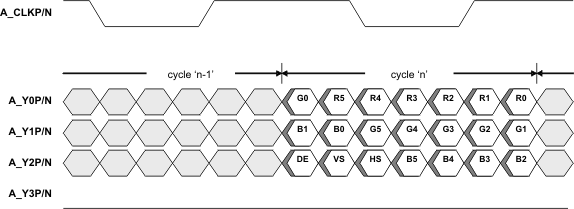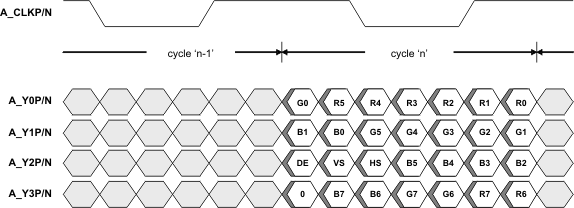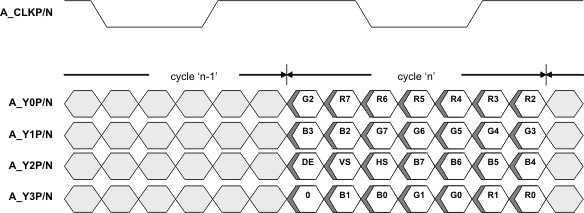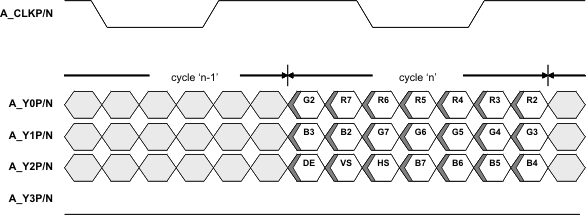SLLSEW7A December 2016 – June 2018 SN65DSI83-Q1
PRODUCTION DATA.
- 1 Features
- 2 Applications
- 3 Description
- 4 Revision History
- 5 Pin Configuration and Functions
- 6 Specifications
- 7 Parameter Measurement Information
-
8 Detailed Description
- 8.1 Overview
- 8.2 Functional Block Diagram
- 8.3 Feature Description
- 8.4 Programming
- 8.5
Register Maps
- 8.5.1
Control and Status Registers Overview
- 8.5.1.1 CSR Bit Field Definitions – ID Registers
- 8.5.1.2 CSR Bit Field Definitions – Reset and Clock Registers
- 8.5.1.3 CSR Bit Field Definitions – DSI Registers
- 8.5.1.4 CSR Bit Field Definitions – LVDS Registers
- 8.5.1.5
CSR Bit Field Definitions – Video Registers
- 8.5.1.5.1 Register 0x20
- 8.5.1.5.2 Register 0x21
- 8.5.1.5.3 Register 0x24
- 8.5.1.5.4 Register 0x25
- 8.5.1.5.5 Register 0x28
- 8.5.1.5.6 Register 0x29
- 8.5.1.5.7 Register 0x2C
- 8.5.1.5.8 Register 0x2D
- 8.5.1.5.9 Register 0x30
- 8.5.1.5.10 Register 0x31
- 8.5.1.5.11 Register 0x34
- 8.5.1.5.12 Register 0x36
- 8.5.1.5.13 Register 0x38
- 8.5.1.5.14 Register 0x3A
- 8.5.1.5.15 Register 0x3C
- 8.5.1.6 CSR Bit Field Definitions – IRQ Registers
- 8.5.1
Control and Status Registers Overview
- 9 Application and Implementation
- 10Power Supply Recommendations
- 11Layout
- 12Device and Documentation Support
- 13Mechanical, Packaging, and Orderable Information
Package Options
Mechanical Data (Package|Pins)
- PAP|64
Thermal pad, mechanical data (Package|Pins)
- PAP|64
Orderable Information
8.3.6 LVDS Output Formats
The SN65DSI83-Q1 device processes DSI packets and produces video data driven to the LVDS interface in an industry standard format. Single-Link LVDS is supported by the SN65DSI83-Q1 device. During conditions such as the default condition, and some video synchronization periods, where no video stream data is passing from the DSI input to the LVDS output, the SN65DSI83-Q1 device transmits zero value pixel data on the LVDS outputs while maintaining transmission of the vertical sync and horizontal sync status.
Figure 9 illustrates a Single-Link LVDS 18-bpp application.
Figure 10 illustrates a Single-Link 24-bpp application using Format 2, controlled by CHA_24BPP_FORMAT1 (CSR 0×18.1). In data Format 2, the two MSB per color are transferred on the Y3P/N LVDS lane.
Figure 11 illustrates a 24-bpp Single-Link application using Format 1. In data Format 1, the two LSB per color are transferred on the Y3P/N LVDS lane.
Figure 12 illustrates a Single-Link LVDS application where 24-bpp data is received from DSI and converted to
18 bpp data for transmission to an 18-bpp panel. This application is configured by setting CHA_24BPP_FORMAT1 (CSR 0×18.1) to 1 and CHA_24BPP_MODE (CSR 0×18.3) to 0. In this configuration, the SN65DSI83-Q1 device does not transmit the 2 LSB per color since the Y3P and Y3N LVDS lane is disabled.
NOTE
Figure 9, Figure 10, Figure 11, and Figure 12 only illustrate a few example applications for the SN65DSI83-Q1 device. Other applications are also supported.



